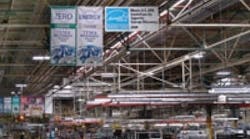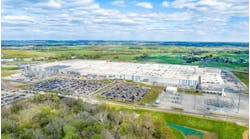These days, all things green are occupying a prime place in the public consciousness, and those same core issues manufacturers have been dealing with forever -- energy use and waste reduction, pollution prevention, supply chain management and environmental compliance reporting -- have been given a green makeover. Now everyone, from your most valued suppliers to your biggest customers down to your employees, shareholders and consumers, is demanding that you reduce your global footprint -- and that's not even taking into account the footprint looming government regulation may leave on your income statement.
Addressing the desires of these disparate interest groups has never been more important. Luckily, there's a number of tools, services and ideas available to help manufacturers face these challenges, many of which are coming from the same sources -- your customers and your employees, and even the government -- demanding that you reduce your environmental impact in the first place.
And the best part is, you already know the process -- in many ways, green is just a new twist on the old game of continuous improvement.
Energy Kaizens
"One of the first things I do is ask, If tomorrow your electricity price doubled, your gas price doubled, and carbon output was being taxed at $20 per ton, would you still be in business?'"
So says Toledo, Ohio-based energy consultant Peter Garforth, one of a crop of business consultants who are helping manufacturers devise expanded energy and carbon risk management strategies.
At Louisville, Ky.-based energy consultancy Summit Energy, vice president Jason Miller and manager of energy sustainability John Hoekstra have never been busier as their clients look to get a handle on the new energy environment. "If you look at sustainability as a whole, the drumbeat that we've heard from our clients has definitely increased in the last 18 months," says Miller.
According to Miller, this new corporate rhythm results primarily from the pounding Summit's clients are taking on operating income as energy prices skyrocket, as well as jockeying for position in the conga line of corporate social responsibility. Although he admits that this latter reason has led to a rise in energy audit sales, Miller is quick to stress that these "green audits" are not public relations events -- at their core they are essential business activities that just happen to have an extra marketing bonus these days. "We're helping our customers balance environmental objectives with financial or economic sustainability as well," he says. "And we're giving them something they can talk about to the community in which they operate."
Regardless of the reason behind them, the payoffs from these energy kaizen events make for good press for both Summit and its customers. "In the last 30 months we've been in 179 plants in the U.S., and we've identified 865 projects," Hoekstra relates. "They had an annual energy spend of $461 million, and we identified $45 million in savings with an average simple payback of two years or less." Those kinds of numbers should please both shareholders and stakeholders, as well as making a nice bullet point on a corporate sustainability report, says Miller.
Green = Lean
Talk to manufacturers "walking the talk" in green operations, and you find that some of the same principles that form the typical continuous improvement (CI) toolbox -- notably, waste reduction and supplier and employee engagement -- also form best practices for environmentally responsible manufacturing.
|
Perhaps mindful of the role it may soon play as enforcer of carbon regulations, the U.S. government has stepped up its efforts to assist the manufacturing sector in getting with the sustainability program. For example, the Environmental Protection Agency's (EPA) Energy Star certification has been extended so that entire manufacturing facilities (such as Toyota's Georgetown, Ky., facility) are being recognized for efficient operations. EPA Climate Leaders is another program that is aggressively seeking both leadership and membership from companies in the manufacturing sector. Grants and incentives are available from all levels of government for a variety of energy-efficiency and waste reduction projects, as well as alternative energy installations. Finally, non-profits, consultants and industry associations are all continually improving their own offerings, all with the goal of helping manufacturers sustain their businesses in a sustainable fashion. |
Guardian Industries, a multibillion-dollar manufacturer of commercial and residential glass, has glass plants in over 24 countries and has had a robust environmental plan since 1993, or, as chief technical officer Scott Thomsen puts it, "before green was a mega-trend." Thomsen says that the genesis for Guardian's aggressive environmental policy stemmed from the company's original CI initiatives. In fact, Thomsen sees green and lean as inescapably intertwined.
"Green is lean because both are about doing more, or at least the same, with less," says Thomsen. "It's about reducing waste, be it time or materials. And both are about getting things to the right place at the right time -- or using the right things in the right way in the right amount."
The common-sense outlook Thomsen advocates is that reduction of waste, emissions and pollution is something most manufacturers aspired to long before the current mega-trend hit. Boiled down to its base, green is simply good business, says Thomsen. "It's operationally beneficial to avoid the consumption of resources in the first place and to prevent pollution and emissions from occurring, rather than clean-up or disposal, or installing expensive pollution control equipment."
Supplier Engagement
A recent survey of manufacturers commissioned by Dow Corning reveals that eight out of 10 companies globally say that environmental and sustainability factors are taken into account when they select suppliers.
Grand Rapids, Mich.-based furniture manufacturer Steelcase is among that number. According to supply chain manager Mary Ellen Mika, the direct benefits are twofold: reduced cost and increased credibility (courtesy of a "Cradle to Cradle" designation by certification firm McDonough Braungart Design Chemistry), and the indirect benefits are shared along the value chain. "We offer our suppliers the benefit of using our consultants, and we cover the cost," she says. "After they reduce their cost through reducing waste and lean improvement methods, they can pass those savings on to us, or position themselves for getting more business."
Some customers are more aggressive than others, and chief among tough customers is retail giant Wal-Mart, which is pursuing a set of impressive sustainability initiatives in its usual massive, methodical and relentless fashion.
According to James Stanway, Wal-Mart's director of product development, the retailer is very proactive about using its unparalleled leverage with suppliers, sending its army of logistics engineers and energy auditors out onto the factory floors of even its smallest suppliers. "We were inefficient when we were small," he relates. "So we don't mind helping them out, and it comes back to us in reduced cost."
Wal-Mart recently undertook a partnership with suppliers in seven key product verticals to determine the carbon footprint of seven typical products. Stanway maintains that the expense for this project will pay for itself by further increasing supply chain visibility, aiding the giant retailer in its never-ending quest for operational efficiency.
Stanway even draws a direct parallel between environmental and quality improvement initiatives, saying that in his experience, "Knowledge of carbon footprint is actually a good proxy for product quality."
Employee Engagement
Finally, as in any successful CI initiative, employee participation is vital to getting the most value for the investment of effort. And if you play your cards right, empowered employees can be your best marketers, says consultant Bob Willard, author of The Sustainability Advantage. "Ensuring that employees agree with your assertions first is critical, and that's a lot easier to do if you involve them, and let them drive the process," Willard says.
Echoing the employee engagement principle, Summit's Miller says that both executive and employee sponsorship are crucial for long-term success so that the low-hanging fruit, once found and picked, doesn't grow right back.
"In order for an efficiency solution to be sustainable, it's got to be sponsored by the COO, but it's also got to be supported by the facilities engineers who know the plant better than anyone else," he says.
Examples of the benefits of this "green team spirit" are abundant in the manufacturing arena. Xerox's Earth Awards employee suggestion program, for example, features teams of employees from various disciplines who have, among many other things, devised a solution that drastically reduces the amount of water used in a key plant process -- an important step since water use, like carbon emissions, will likely become constrained in coming years.
Executives at 3M credit employee involvement at all levels, and particularly those in manufacturing and technical positions, for the three decades of success of its "3P" (Pollution Prevention Pays) program, an effort that so far has generated more than 6,300 employee-driven suggestions with first-year savings of more than $1 billion dollars.
According to Willard, research shows that large companies with robust sustainability programs can increase profits "by a minimum of 38% over five years, and small- and medium-sized companies can increase profits by a minimum of 66% in the same time frame." And continuous improvement of profits is the kind of green everyone can agree with.




